

Featured Article of the Month
25 Years And On - Interview With Yuichiro Kubo
| In October, JCC interviewed Yuichiro Kubo, an educator at Temasek Polytechnic (TP). He first came to Singapore in the mid-1990s, as a student at National University of Singapore. Now, he is an educator teaching core subjects on globalisation at TP and one of the founding members of the institution’s Centre for Transcultural Studies, leading initiatives on cross-cultural exchanges for students at the Glocal Village. |
|
Japan Creative Centre (JCC): Tell us about how you came to Singapore and why you chose to eventually settle down here.
Kubo (K): I chose to come to Singapore because the Great Hanshin Awaji Earthquake affected me a lot. When the earthquake happened in 1995, I was a post-graduate student in Nishinomiya. At the time, I was writing my doctoral thesis, but I felt that I couldn’t continue to sit and write my thesis when people were suffering out there. I had actually lost one professor in the disaster, which made me think about the meaning of life and how I could contribute to society. I thought about whether I was suited for the academic world, or if it would be better for me to look for more down-to-earth, hands-on work. |
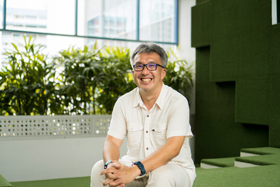 |
|
Before this, in 1990, I was an exchange student at National University of Singapore (NUS). I was sent here by Japan’s Ministry of Education, Culture, Sports, Science and Technology (MEXT). It was there that I met my girlfriend, who is now my wife. She was very realistic, and advised me to come over to Singapore because she felt I could not live doing just volunteer work. She also introduced me to polytechnics, which interested me and I applied for a part-time position at TP. I was converted to full-time staff after a year and since then, I have spent 25 years in TP.
I clearly remember touching down in Singapore on 15 May 1995. I felt that Singapore culture in the 1990s was more family-oriented. This was not very different from Japan, which is nuclear family-oriented. I was really surprised and I valued it a lot. JCC: You worked in TP for 25 years. How has your position changed, and what is your current job scope? K: Initially, my primary job was to teach the Japanese language. In the 1990s and early 2000s, Japanese culture was at its peak thanks to the popularity of Pokémon, anime, and Japanese fashion. Every year I had to teach over 2000 students. It was a really popular subject and at one time, we had 10 Japanese language teachers. With experience, I became more interested in developing cultural understanding in my students, so I started teaching a subject called Global Citizenship where I taught students about regional globalisation. This subject focused on the appreciation of different cultures in Southeast Asia, and raising awareness on standards of living in other countries in the region. I brought my students to Ho Chi Minh City in Vietnam. We would spend a week doing exchange programmes, participating in industry seminars and historical studies. The trip gives students a culture shock, but many love it because the study trip is fruitful. |
| After that, I advanced my interests in the area of communication, and I am now teaching Global Studies. In this subject, we introduce societal diversity and teach students to appreciate different cultures on an international level. The subject also emphasises regional value, focusing on the culture and history of neighbouring countries. This subject is one of TP’s fundamental subjects, which means all students must take this subject. In the future, students will work in ASEAN countries and cooperate with people across the region. It is important for them to understand the values and customs of those countries. | 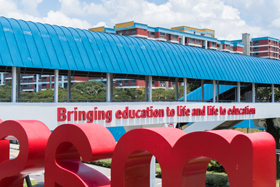 |
|
I was also a founding member for the Centre for Transcultural Studies, which built a new space in TP called the Glocal Village. The term ‘glocal’ is a compound word combining the terms ‘global’ and ‘local.’ The underlying meaning there is that we want the Glocal Village to be the hub for educating and nurturing cultural understanding in the midst of globalisation by letting students embrace global and local values together. Besides it being a centre of cross-cultural studies, we also designed the Glocal Village to be a communication space. We host many international symposiums and exchange programmes, so that it serves as a space where different cultural groups can mingle, meet up, and understand each other better.
JCC: Are there Japan-related programs in TP? K: The Japanese Government has a programme called the JENESYS (Japan-East Asia Network of Exchange for Students and Youths) programme. Almost every year, up until COVID-19 hit in 2020, our students have participated in the programme to go to Japan to learn more about the country. It is a very good programme and I hope it will restart again after the pandemic. |
| One of my key responsibilities is to give advice and support the students’ trips to Japan. Logistics, planning, and scheduling in Japan is not easy as the arrangement of transport and accommodation is mostly done using Japanese. When the Principal & CEO needed to go to Japan, I accompanied and supported him as well. The Former Principal of TP was active in building relationships with Japanese technical colleges and we were able to sign Memorandums of Understanding (MOU) with 51 technical colleges in Japan. We also have a diverse range of annual exchange programme as well. This way, we can provide more opportunities for students to have cultural exchanges and provide them with first-hand experiences. | 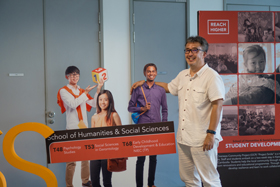 |
|
JCC: Can you share more about other initiatives you have started in TP?
K: I was advisor to the Japanese Cultural Group, which is now celebrating its 20th Anniversary. They conduct activities such as cooking, drawing manga, and folding origami. When the Great East Japan Earthquake happened in 2011, students immediately approached me and talked about fundraising. As I mentioned earlier, we also have exchange programmes with technical colleges in Japan. At the time, one of our exchange students was from a technical college in Sendai, and their campus was affected by the tsunami. Immediately, we started fundraising activities which many staff came and contributed to. Many showed compassion, and they wished to donate to not only help with reconstruction efforts but also to show their appreciation and encouragement for the students. JCC: How did Temasek Polytechnic start nurturing its links between Japan and Singapore? K: The Former Principal and CEO of TP, Mr Boo Kheng Hua, was very passionate about Japan. He once attended a 3-month training session at Seiko in Japan. During the training, he felt the importance of the values and philosophy taught in the line of Japanese manufacturing. He came back and shared his experiences and philosophy of Seiko with me and other educators at the institution. With globalisation, Japan needs supporters in organising international cooperation with foreign countries. Seeing that, he thought that it was within his capacity as a principal of a polytechnic to collaborate with Japanese technical colleges. This was the contribution that was made by him, and I was happy to support this collaborative project between Singapore and Japan. TP has been maintaining this good relationship with Japanese technical colleges and educational institutions. The second principal has also expanded and deepened the international relationship with his special training experience in Japan. I am also trying to contribute in this area to sustain this relationship. |
|
JCC: What kind of changes have you seen in these past 25 years among students’ view on Japanese culture?
K: As you know, K-pop is currently very popular. However, there still are hard-core lovers of Japanese culture. There is still a great demand for Japanese language courses and cultural appreciation classes from students at TP. Students are still very eager to attend events organised by Japanese community groups, like the Japanese Association and Japan Creative Centre. |
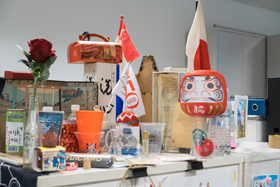 |
|
Those who really love Japanese culture and language repeatedly go back to Japan to absorb more experiences first-hand. I’ll say that the core number of students with deep interest in Japanese culture and its underlying philosophy, has not changed. There even are some students who have gone on to Japan to study. Some go to Japan to learn how to make sushi. Some train as hairstylists. Some want to be designers, because Japan is still one of the leading countries in fashion, and so forth.
I always aim to be a bridge between Japan and Singapore. Whenever I see activities related to Japan, I try to support by participating or publicising the event to staff and students as I think they can all benefit from all these events. JCC: How do you teach Japanese culture to your family, and how do you preserve these Japanese traditions alongside Singaporean traditions? K: My wife was brought up in a family that loves Japanese culture. Her father was a trader that did business with the Japanese. As a child, my wife was interested in Japanese language and she later majored in Japanese Studies at NUS. She went on to have a job in Japan actually. She worked in Kobe, and as I mentioned earlier, my graduate school was in Nishinomiya, which is in the Kansai area. Kobe is half an hour away by train from Nishinomiya, so our relationship continued. We have four children now – three sons and one daughter. They were exposed to Japanese culture through daily activities with me. I speak only in Japanese at home, and I watch Japanese TV programmes dramas and anime with them. Sports anime like Slam Dunk was quite popular then, so we watched it together. They are okay at Japanese conversation, so they can volunteer and support exchange programmes. All four of them have their own careers, and they each use their knowledge of Japanese as strength too. |
| I try to instil cultural values, for example, showing appreciation for simple things by saying “arigato”. When we take the bus in Japan, we always say “arigato” to the driver, which surprises them. They get even more surprised when we say we are from Singapore. (laughs) I also maintain some Japanese traditions at home. When we celebrate New Year’s Eve, we watch “Kohaku” (“NHK Kohaku Uta Gassen” is an annual New Year’s Eve television special featuring popular music artists that has run in Japan since 1953), and eat toshikoshi soba (年越し蕎麦, a traditional noodle dish eaten on New Year’s Eve) if possible. Osechi ryori (お節料理, traditional foods that are eaten on New Year’s Day) is very expensive so I can’t buy the whole set but we will choose items that my kids and wife love to eat like datemaki (伊達巻き, Japanese New Year’s rolled omelette) and kuri-kinton (栗きんとん, candied chestnuts). | 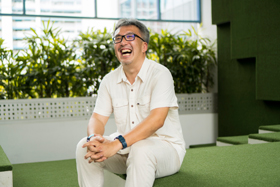 |
|
Not forgetting our roots in Singapore, we also celebrate and appreciate public holidays like the Lunar New Year. Singapore is a multi-racial society, with festivals that cannot be experienced in Japan. By celebrating traditions from both cultures, my kids are able to know more about different cultures, practices, and sources of festivals. Sometimes they compare ang pao (Chinese red packets) and otoshidama (お年玉, monetary gift given to children during New Year’s) and ask “How come Singapore is this way, and how come Japan is this way?” (laughs)
JCC: How did you learn Teochew? K: My kids are forced to speak Japanese with me but they speak English with my wife. When my wife’s grandmother, ah ma, was still around, all of us including me and kids, had to use Teochew with her. Ah ma took care of my four kids, so I learned Teochew by listening to her sing lullabies and tell stories. I would joke around with her and she would say that I was cheeky and impolite. (laughs) I enjoyed interacting with her, and it was a good opportunity for me to learn all this Teochew vocabulary. I learned by listening. After she repeats certain phrases multiple times, I began to understand. This is how I learned Teochew for 11 years. It’s the same with my children. To master Japanese, they spoke in Japanese to me and repeated words. |
|
JCC: Based on your experiences and from your perspective, how can Singapore and Japan learn from one another?
K: I think Singapore and Japan can learn from each other’s strengths. Singapore has internationalised itself successfully and maintains a high global standard. Japanese people can learn how to think internationally in terms of education and business practices. Japan can also learn to embrace diversity and inclusiveness from Singapore. Singapore is leading in these areas and has successfully built a multi-racial society. |
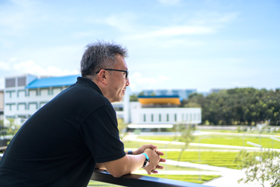 |
|
Singaporeans might be able to learn about traditional mastership from the Japanese. Japan still leads in manufacturing, moulding, and different kinds of leading technology. A lot of this is rooted in Japanese tradition.
Both countries have rapidly ageing population and a low birth rate, so the same challenges are ahead of us. We have to overcome these two obstacles using different approaches. If Japan and Singapore marry modern and traditional approaches, we can strive to find a core solution in the next decade. Watch the interview here. * All photos used in this article are taken by JCC / © JCC |
|
Japan Creative Centre 4 Nassim Road, Singapore 258372 +65 6737 0434 / jcc@sn.mofa.go.jp https://www.sg.emb-japan.go.jp/JCC/ Nearest parking at Orchard Hotel & Delphi Orchard |
 |